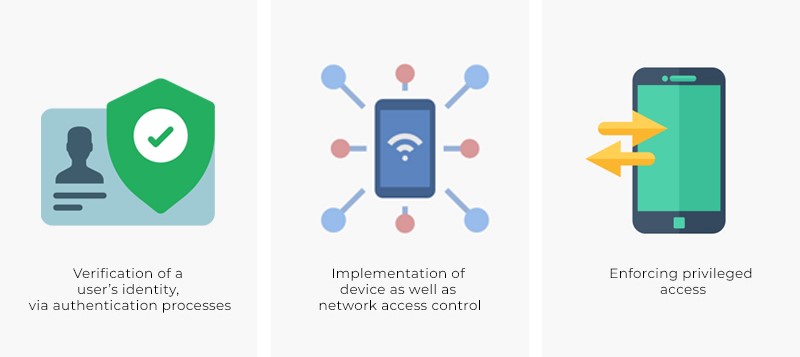Zero Trust is a security framework, which requires all users to undergo authentication, authorization, and validation to get access to key applications and data. This concerns users within and outside the organization, as well.
This model is based on the assumption that there is no network edge. The networks, in this case, can be arranged locally, in the cloud, or maybe in a hybrid. In today’s modern times, Zero Trust network security is desired by most businesses looking at securing their infrastructure and data as a part of today’s digitally transformed landscape. Almost 63% of organizations across the world have fully or partially implemented a zero-trust strategy, according to studies.
If you want to understand about this secure network in more detail, read on.
What Is Zero Trust Security? – Simplified For You
This has been hailed as one of the most ultra-secure and safe defenses against cyber threats. It is different from perimeter security in various ways. One is that users inside the organization also need to acquire the necessary authorization and authentication, before getting access to crucial devices and data.
Most organizations have legacy security systems, which run on hard-coded passwords which are considered outdated, in today’s times. It can put the data in breach, ultimately damaging the company’s reputation. In the realm of the zero trust security model, many vendor-neutral and comprehensive standards exist, for both private as well as government organizations.
Zero Trust is a cloud security offering, whose firewall systems can keep data encrypted and secure, even in the instance of a breach. However, one may face several challenges during its implantation. Proper integration of the company’s security technologies, financial resource allocation, and compliances must be able to congregate at some point so that Zero Trust can be implemented.
Moreover, the proper implementation of Zero Trust requires financial resources, along with skilled manpower to enforce and handle the same.
The Zero Trust network security model operates on a three-step process, which includes the following stages:

This model enforces the idea that organizations must not trust any individual, whether they are inside or outside the organization.
Importance of Zero Trust in Modern Cybersecurity
So, by now, you may have quite a few ideas as to why Zero Trust has assumed so much importance. Today, cybersecurity incidents range from phishing to ransomware attacks. Then denial-of-services attacks are also quite common. There has been a substantial increase in organizations adopting cloud services, IoT, and remote workforce management.
So, such new-age workplace processes call for improved security. When a business adopts Zero Trust, it is moving towards solutions that are agile and secure.
Additionally, a recent report released in 2024, revealed that 59% of organizations experienced a software supply chain attack. Here are a few reasons why every new-age organization or those which have embraced the digital revolution, require Zero Trust architecture.
Ineffectiveness of Perimeter-based Security
As the business is constantly evolving, with digital technologies assuming importance, traditional cybersecurity models are failing. Only zero trust network takes a target-oriented approach in authenticating and approving user access requests, within the network.
This means that nobody has unhindered access to the network or available data, whether an insider or outsider. All requests undergo continuous monitoring and verification, to access various parts of the network.
Adoption of Cloud Storage Stressing Shared Security
As critical applications move towards public storage or hybrid cloud systems, legacy cybersecurity models stand obsolete. You cannot assume that the public or hybrid space is secure enough. Thus, this new cloud environment requires shared responsibility for security. Hence, a zero trust authentication model comes into the picture.
Low Level of Trust on SaaS and PaaS Pushing Boundaries
Most applications are now offered as SaaS or PaaS models. Most software OEMs develop applications with authentication mechanisms, logging, and ML. The core logic as well as the business logic are both OEM-owned.
However, the ownership of the software components used to build applications lies elsewhere. Thus, application developers cannot trust their own creations.
Only Zero Trust can come to the rescue here, as the security controls are deployed keeping compromises at present. It uses least privilege and continuous verification principles at every stage.
Low Level of Trust On Work-From-Home Environments
As WFH is the new normal, even after three years of the pandemic, security measures encompassing remote workers are no longer applicable. With almost half of the workforce still working remotely, security technologies of the past are no longer valid.
So, today’s businesses must assume that workers are actually working in an insecure environment. In such a scenario, only the zero trust network security remains trustworthy.
These are just a few of the reasons, which make Zero Trust more noteworthy.
Key Challenges in Implementing Zero Trust Security
- Legacy Systems and Infrastructure
Many organizations have legacy systems that need Zero Trust adoption. This requires additional resources, many changes in existing systems, or upgrades as well. This is to ensure the proper compatibility and compliance management.
Many hybrid networks often work on a mixture of networks, like cloud, private, or public. Unifying these with a zero trust architecture can be a bit challenging, due to variations in tech stacks, security funnels, and architecture.
- Cultural and Organizational Resistance
You can call this as one of the primary hurdles in adopting Zero Trust. This technology requires organizations to shift from a traditional or legacy security mindset to a zero-trust one.
Most managers and employees are aware of the loopholes and also understand the better standards of new-age systems, but are not ready to change, as they have to unlearn and relearn things.
- Complexity of Implementation
Another zero trust challenge is associated with the cost of implementation. It mainly revolves around the integration with legacy systems. Most businesses operate on an outdated structure which cannot integrate with Zero Trust, instantly. This makes the transition technically challenging.
- User Experience and Productivity Concerns
Continuous authentication and strict access control measures can be dismay for users. This often leads to internal resistance, if left unaddressed. This can also lead to non-compliance and also lower the effectiveness of the Zero Trust security model.
- Data and Identity Management
Many organizations are facing the challenge of advanced threats, ransomware attacks, and other malicious activities. These mostly target identity data.
The shift from traditional storage to cloud-based storage has also brought new challenges in the management of identities across various cloud platforms. The excess use of mobiles to address work apps and work-from-home has further aggravated this issue.
- Scalability and Performance Issues
This is another issue plaguing businesses, related to Zero Trust security network adoption. Data transmission slows down as a result of its adoption, as there is a huge gap between legacy and Zero Trust measures. It mainly arises due to differences in technological and operational perspectives.
These are the zero trust challenges, which organizations have to overcome in today’s times, to make it a part of their operations.
Strategies for Overcoming Zero Trust Security Challenges
There are quite a few strategies that will help in overcoming the challenges related to Zero Trust implementation.
Building a Comprehensive Zero Trust Roadmap
Implementing Zero Trust is not a one-time turnkey project, which you start, deploy, and finish, in a few days or weeks. It is an ongoing process, which you have to look at in a holistic manner. The biggest gaps arise, while you are in the process of replacing legacy systems.
You have to start from ground zero, and slowly work your way up. Identifying the users, devices, data, monitoring the tools, and setting up access controls, take center stage. Additionally, you require secure hardware and software as well. Your workflow needs to be in place, from the beginning.
Engaging Stakeholders and Building Consensus
It involves engaging the stakeholders from different departments, to understand their security-related concerns. Thereafter, you are supposed to evaluate their effectiveness over existing measures. This process will ensure actionable insights that can help a business develop its strategy.
Leveraging Advanced Technologies and Solutions
In order to execute the Zero Trust framework, the business needs to take into account advanced technologies like multi-factor authentication, endpoint security, and identity protection. A robust cloud technology also needs to be deployed to verify users and systems.
Maintenance is also very crucial for the encryption of data, and email attachments, and also in the verification of the hygiene of assets.
Ensuring Continuous Monitoring and Improvement
The Zero Trust architecture also requires organizations to continuously monitor and validate users, devices, and data. One-time validation does not suffice in Zero Trust. Thus, organizations must utilize all available technologies with constant upgrades to monitor the ongoing situation, and overcome the same, if necessary.
Conclusion: The Path Forward for Zero Trust Security
Today, Zero Trust architecture assumes a lot of importance in the realm of cybersecurity, as criminals are always on the prowl. Study reveals that by 2026, 10% of large enterprises will utilize zero-trust programs.
It mainly stresses least-access models for all the users related to a business’s network and data. Thus, it makes it very important for all organizations to adopt the above policies and solutions, to make way for a better future. Organizations must make use of cloud-native security features and tools to create a secure framework for success.
Other Blogs

From Nuclear Centrifuges To Machine Shops: Securing IoT
IoT or ‘the internet of things’ has been around for a lot longer than the buzzword
Read More


Demystifying XDR
As the capabilities of threat actors have increased so have the tools which we utilize to detect and respond to their activities.
Read More


Cybersecurity In A Post Pandemic World
As many cyber security practitioners will tell you, the most imminent and dangerous threat to any network are the employees accessing it.
Read More


